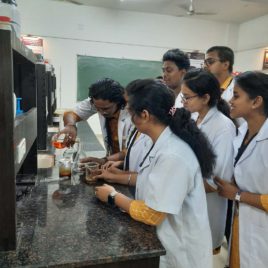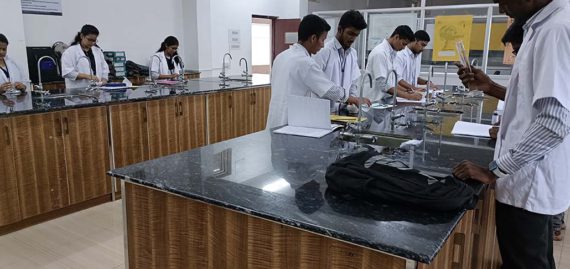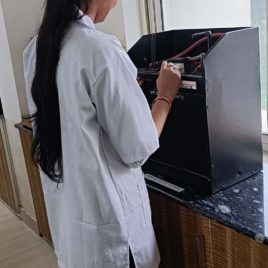Designing and synthesizing physiologically active compounds is the focus of pharmaceutical (medicinal) chemistry. The goal is to acquire new chemical molecules that could facilitate the discovery of novel medicines or optimize currently established drug structures hence increasing the range of available chemical therapeutics. Even though organic chemistry is essential only skilled pharmaceutical chemists can collaborate with scientists of other field such as molecular biology, structural biology, pharmacology, physical chemistry, biochemistry, pharmacokinetics, pharmaceutical technology, toxicology etc., and work effectively in interdisciplinary environment.
Pharmaceutical Chemistry
Domain Track: Pharmaceutical Chemistry
Course Attendees
Still no participant
Course Reviews
Still no reviews
Domain Track Code (Credit): PCCU2370 (4-0-0)
Courses Division:
- Physical Chemistry of Pharmaceuticals
- Essentials of Pharmaceutical Chemistry
- Analytical Techniques for Pharmaceutical Drugs
Domain Track Objectives:
- To know the classification of drug, physical properties and its mechanism of action on human physiological system.
Domain Track Learning Outcomes:
- To know various types of drugs and its application towards the diseases.
- To understand physical and chemical behavior of drugs by using instrumental methods.
- Students will understand different physico-chemical properties pertaining to biological actions.
Career Scope:
- Pharmaceutical industries (R&D, F&D and Analytical)
- Regulatory affairs (Quality control and Quality assurance)
- Sales and marketing
- Patent attorney
- Pharmacovigilance
- Biomedical researcher
Domain Syllabus:
Module-I
- Basic Principles of Medicinal Chemistry: Physico-chemical aspects (Optical, geometric and bioisosterism) of drug molecules and biological action. Basic concepts of: Drug metabolism, Prodrugs, Receptors and drug receptor interaction.
Module-II
- Solubility of drugs: Solubility expressions, mechanisms of solute solvent interactions, ideal solubility parameters, solvation & association, factors influencing solubility of drugs, quantitative approach to the solubility, diffusion principles in biological systems.
Module-III
- Classification and uses of the following classes of drugs, with some suitable examples.
- Drugs acting on Gastrointestinal tract.
- Drugs acting on Central nervous System, Hormones and related drugs, Drugs affecting cardiovascular system, Drugs acting on Blood and Blood Formation
Modules-IV
- Classification and uses of the following classes of drugs, with some suitable examples.
- Chemotherapeutic agents, Antibiotics
Modules-V
- UV-Visible spectroscopy: Beer and Lambert’s law, Derivation and deviations. Instrumentation. Applications. Spectrophotometric titrations, Single component and multi component analysis.
- IR spectroscopy: Introduction, fundamental modes of vibrations in poly atomic molecules, sample handling, factors affecting vibrations and Instrumentation.
Reference
- Wilson and Giswold’s Organic medicinal and Pharmaceutical Chemistry.
- Essentials of medical Pharmacology, KD Tripathi, Seventh Edition, 2013, Jaypee Brothers Medical Publishers (P) Ltd.
- Medicinal Chemistry by Ashutosh Kar, New Age International Publishers, 5th revised and expanded Edn, 2010.
- Foye’s Principles of Medicinal Chemistry, Lippincott Williams & Wilkins, 7th Edition, 2012.
- Instrumental Methods of Chemical Analysis by B.K Sharma
- Organic spectroscopy by Y.R Sharma
- Text book of Pharmaceutical Analysis by Kenneth A. Connors
- Physical Pharmacy by Alfred Martin
Session Plan for the Entire Domain:
Session 1
- Basic Principles of Medicinal Chemistry
- PDF: Lecture note on Basic Principles of Medicinal Chemistry
- Lecture note on Basic Principles of Medicinal Chemistry
Session 2
- Physicochemical aspects of drug
- Web link
Session 3
- Stereochemistry of drugs
- Web link
Session 4
- Pharmacodynamics of drug-I
- PDF: Lecture note on Pharmacodynamics of drug
- Lecture note on Pharmacodynamics of drug
Session 5
- Pharmacodynamics of drug-II
- PDF: Lecture note on Pharmacodynamics of drug
- Lecture note on Pharmacodynamics of drug
Session 6
- Solubility of drugs
- PDF: Lecture note on solubility of drugs
- Lecture note on solubility of drugs
Session 7
- Quantitative approach to solubility
- PDF: Lecture note on quantitative approach to solubility
- Lecture note on quantitative approach to solubility
Session 8
- Drugs acting on Gastrointestinal tract
- PDF: Lecture note on Drugs acting on GIT
- Lecture note on Drugs acting on GIT
Session 9
- Drugs acting on Central nervous system
- PDF: Lecture note on Drugs acting on CNS
- Lecture note on Drugs acting on CNS
Session 10
- Hormonal drugs
- Web Link
Session 11
- Drugs acting on Cardiovascular System
- PDF: Lecture note on Drugs acting on CVS
- Lecture note on Drugs acting on CVS
Session 12
- Drugs acting on Blood and Blood Formation
- PDF: Lecture note on blood and blood formation
- Lecture note on blood and blood formation
Session 13
- Chemotherapeutic agents-I
- PDF: Lecture note on chemotherapeutic agent
- Lecture note on chemotherapeutic agent
Session 14
- Chemotherapeutic agents-II
- Lecture note on chemotherapeutic agent
Session 15
- Antibiotics-I
- Lecture note on antibiotics
Session 16
- Antibiotics-II
- Lecture note on antibiotics
Session 17
- Antibiotics-III
- Lecture note on antibiotics
Session 18
- Antibiotics-IV
- Lecture note on antibiotics
Session 19
- Antibiotics-V
- Lecture note on antibiotics
Session 20
- Electronic transitions, chromophores, auxochromes, spectral shifts
- Lecture note on electronic transitions, chromophores, auxochromes, spectral shifts
Session 21
- Solvent effect on absorption spectra, Beer and Lambert’s law, Derivation and deviations
- Lecture note on Solvent effect on absorption spectra, Beer and Lambert’s law, Derivation and deviations
Session 22
- Instrumentation - Sources of radiation, wavelength selectors, sample cells, detectors- Photo tube, Photomultiplier tube, Photovoltaic cell, Silicon Photodiode. photodetectors
- Lecture note on instrumentation of UV
Session 23
- Applications - Spectrophotometric titrations, Single-component, and multi-component analysis
- Lecture note on applications of UV
Session 24
- Introduction, Fundamental modes of vibrations in polyatomic molecules
- Web link
Session 25
- Instrumentation - Sources of radiation, wavelength selectors,
- Lecture note on instrumentation of IR
Session 26
- Detectors - Golay cell, Bolometer, Thermocouple, Thermister, Pyroelectric detector
- Lecture note on detectors
Session 27
- Applications of IR spectroscopy
- Lecture note on applications of IR
Media

Our Main Teachers

Mr. Satish Kanhar is currently working as Assistant Professor, Pharmaceutical Chemistry, SoPLS, Centurion University of Technology and Management, Odisha. He has completed M.S (Medicinal Chemistry) in the year of 2014 from National Institute of Pharmaceutical Education and Research, Kolkata. He continued his work in the field of natural product chemistry (extraction, isolation, characterization and their […]










